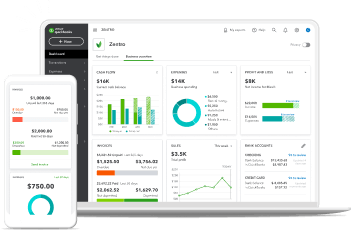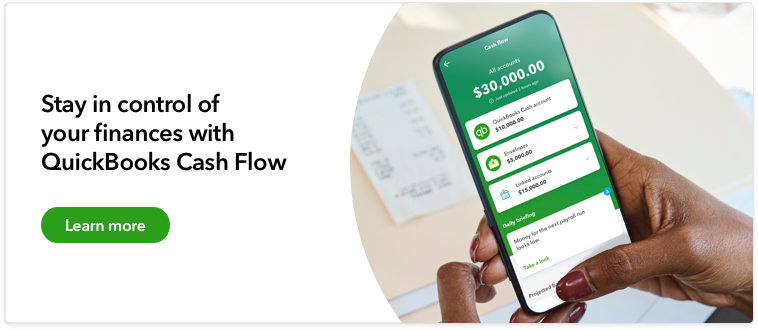Profit and cash flow are both important elements of a healthy, growing business, but they are not the same thing.
To manage your business, you must understand the difference between making money and managing money. Growing businesses often face tighter margins and increased expenses—and it’s not a good idea to try to “out-earn” cash problems. Many business owners are great at selling, but it’s time to get great at forecasting and budgeting as well.
Profit vs cash flow: what is the difference?
Profit is defined as revenue less expenses. It may also be referred to as net income. Cash flow refers to the inflows and outflows of cash for a particular business. Positive cash flow occurs when there’s more money coming in at any given time, while negative cash flow means there’s more money out.
Does positive cash flow mean a business is profitable?
Positive cash flow is not an indication that a business is profitable. Depending on the financial position of a business, a business may be profitable and experience a negative cash flow. Earning revenue does not always increase cash immediately, and incurring an expense does not always decrease cash immediately.
Therefore, there may be a time when your business’s gross sales are up, even while your business has more cash outflow than inflow.
Is profit more important than cash flow?
Both profitability and cash flow are important to a business. A business needs to maintain both to be successful in the long term. However, depending on the circumstances, one may be more critical than the other over a certain period of time.
For example, if a business is turning a profit but has too much cash tied up in inventory or receivables, there may not be enough cash to cover operating expenses like payroll. In this case, cash flow is more important than profitability in the short term.
Over time, if a business cannot reach profitability, it can have a negative impact on cash flow. If a business is unprofitable to the point that it threatens the business’s ability to operate, reaching profitability should be prioritised, since it is essential to a business’s existence in the long run.
Many businesses operate without seeing profits over a period of time. Keep in mind as well that, when necessary, it’s possible to improve cash flow through loans, selling assets or other ways of obtaining capital.
Is free cash flow the same as profit?
Free cash flow (FCF) is a measure of a business’s profitability, but is not equivalent to overall net income.
Net income is the amount of profit that a company has reported over a certain time period. Free cash flow (FCF) refers to the amount of cash a business has available after paying for the operating expenses and capital expenditures (CAPEX)], and it represents the amount of cash available to a business at a given time that could be distributed to creditors or shareholders. FCF can be used to determine if your company is able to expand or restructure, or if it’s likely to see a growth in profits.
Example: the difference between profit and cash flow
Let’s look at an example to illustrate how profit and cash flow differ.
Birchett Mowers manufactures and distributes lawnmowers through hardware stores and other retail locations. Here are three points that illustrate the differences between profit and cash flow:
1. Revenue generated
Birchett sells a $300 lawnmower to a retail store on 1 June and emails an invoice. The business posts $300 in revenue, but the retailer doesn’t pay the invoice until 30 June. Revenue is posted immediately, but the $300 in cash is not collected for 30 days.
2. Expense incurred
Birchett pays $270 in expenses for the lawnmower that was sold. Those expenses are paid in April and May, before the sale of the lawnmower. The business has $270 in cash outflows in April and May before collecting $300 on 30 June.
3. Profit recognised
The profit generated on the lawnmower sale is ($300 – $270 = $30), and that profit is posted on 1 June. In accounting terms, revenue can be recognised on 1 June because the sales process is completed when the product is delivered. The $30 profit is not collected in cash, however, until 30 June.
While Birchett must wait to collect its receivables, other companies do not have this issue. Many businesses collect cash from customers at the point of sale. A retailer, such as Woolworths, receives customer payments at the point of sale through debit card and credit card purchases.
This system allows a retailer to collect cash quickly and makes the cash management process much easier. Birchett’s cash management planning, however, is more complicated.
Cash flow management is different for every business
Birchett earned a $30 profit on the lawnmower sale but had to pay $270 in cash to make and deliver the product to a customer. The firm also had to wait 30 days after the sale to recover the $270 paid in cash and collect the $30 profit. The more products Birchett sells, the more cash it must spend. This situation requires precise cash flow management.
Here are several sources of cash flow for Birchett:
- Collections on prior sales: cash collections from sales in prior months can provide cash to make and deliver products. April and May sales collected in June can provide cash for the manufacturing costs of June. However, if Birchett’s sales are increasing, cash collections from past months may not be sufficient for current production cash needs.
- Delaying cash payments: Birchett may be able to delay cash payments, which would reduce the total amount of cash needed for production each month. Assume, for example, that Birchett purchases metal and other raw materials from Standard Machine. The two parties sign a contract that requires Birchett to deposit 20% of each order in cash and pay the balance in 25 days. This arrangement would improve Birchett’s cash position.
- Raising capital: if Birchett cannot finance its cash needs through the business cash flow, it may need to raise additional capital. Businesses can raise capital by issuing stock, which means that an investor purchases ownership in the company in exchange for cash. Birchett can also raise capital by borrowing funds.
Raising additional capital is the least attractive option for cash management. If Birchett issues stock, the owners are selling a percentage of their interest in the company. Issuing debt requires the company to make interest payments on debt and repay the original principal amount borrowed on time.
Most companies must issue stock or debt to raise enough funds to operate the business.
Increased sales can create cash flow problems
Every business wants to increase sales, but if cash collections do not increase at the same rate, a firm may quickly run short on cash.
Assume that Birchett shifts its marketing focus to a $300 lawnmower that generates a higher profit of $45, and then total sales in July increase from 1,000 to 1,500 lawnmowers. While Birchett’s total profit is higher, the firm must have available cash to produce 500 more lawnmowers that are sold in July.
Situations like this can create a cash crisis. Birchett may accept orders for more lawnmowers, then realise that it doesn’t have enough cash to produce more products. The owners may have to quickly sell stock or find a lender to raise cash, which is not a choice the owners would normally make. Because the firm is under pressure, the owners may sell more ownership or pay a higher interest rate on a loan than they intended.


















